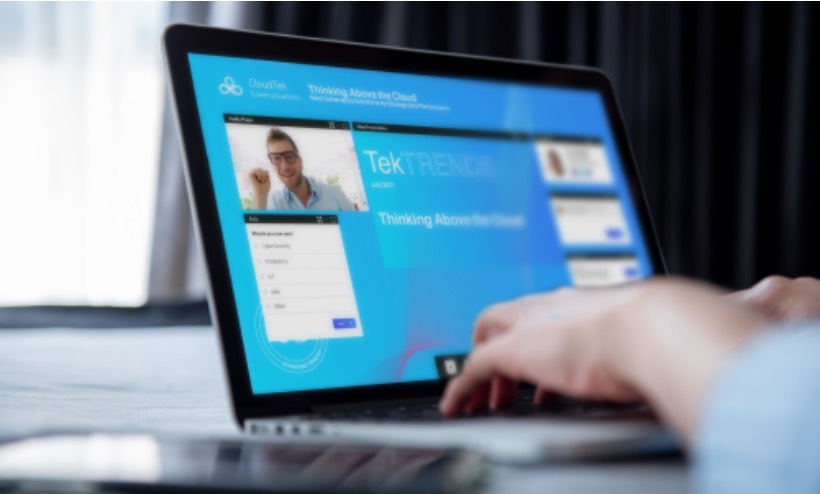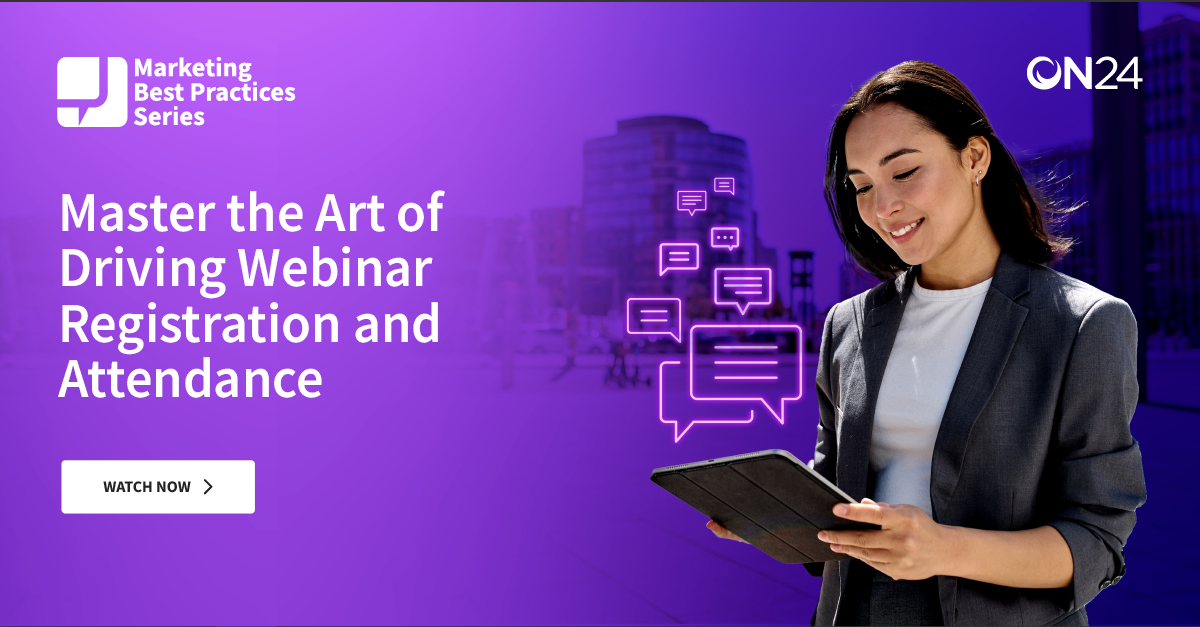How to Drive Successful Virtual Training Webinars

Deploying a virtual training webinar is a powerful tactic companies can use to eliminate costs and effectively train staff.
These interactive, online learning classrooms provide both organizations with a powerful way to scale skills and knowledge while providing employees, clients and more with the opportunity to participate and learn no matter where they are.
There are a lot of tools available to facilitate virtual training, but webinars are a particularly powerful digital channel. This is because, as digital experiences, webinars are:
So how can you get started with an effective digital training program with a webinar platform? Well, let’s take a look.
Kick Your Program Off With An Effective Virtual Training Strategy

There are a few things to consider when your organization starts thinking about spinning up a virtual training program for the first time.
For example, think about what platform is best suited for the type of training you’d like and do. Also, think about finding a suitable trainer to host your program and whether you want to issue certificates, credits and if your platform needs to comply with regulations.
Take the time to think through what you want your training program to achieve — from brand awareness and trust to skill-building and even lead generation.
Once you understand your program’s goal, decide on the technology you’ll want to use and how it’ll fit into your overall tech stack. Here are some questions to consider:
-
- Will your Platform integrate with your CRM if it needs to?
- What about any MAP you’d want to use?
- Does it meet the necessary requirements for accreditation by a governing association?
- Can it track certificate criteria and automatically generate credits?
- Does it provide you insights into where attendees drop off or engage?
- Will you host these lessons in resource hubs?
- Will they be easy to find?
Once you have these questions answered and the structure of your program outlined, it’s time to dive into the nitty-gritty of delivering an effective virtual training webinar.
The Three Most Important Elements of Using Webinars for Effective Virtual Training

There are three main elements of an effective webinar: personality, content and the effective use of visuals.
1. Personality
The instructor and their personality will play a large role in how engaged the attendees are. Interesting, engaging instructors will keep visitors focused on your message and the lessons you want to impart.
This doesn’t mean you need someone who’s veritably leaping out of their seat and into the screen — instructors who are laid-back can work just as well as someone with high energy in a classroom setting — but they ought to be charismatic and enthusiastic.
Here, it helps to interview your virtual instructors, well, virtually. Pay attention to their energy levels throughout the interview. They should be able to captivate your interest and engage you in conversation.
Ask questions about the software they would use and the techniques they’d incorporate in a virtual environment. For example, if it’s a live lesson, would they make use of a Q&A tool? If it’s on-demand, would they respond to questions via email?
Keep in mind: your instructor does not have to be an expert in the field they’re teaching (though it helps). What they must do is effectively communicate the information and lessons you want to share with your audience.
2. Content
When it comes to virtual training, the key deciding factor will be your content. Is it informative? Does it add value? Is it explained in an easy-to-understand manner?
Your course should certainly cover the foundations or basics of any subject, but it should also go in-depth into specific topics/subject areas. Remember: a lot of attendees are interested in learning new information, not just best practices.
If you’re running into issues around the content of your program, reach out and ask attendees how you can improve and evaluate your content’s overall performance with in-depth analytics.
3. Visuals
Think back to your high school days: were your lessons simply lectures and text-heavy passages? Or, were there images, visual aids and diorama as well?
People learn best when there are visual elements to their lessons — and webinars are fantastic tools to provide that visual information in an impactful, concise manner.
Let’s take one of the most basic features as an example: slides. Instructors can use slides within a webinar to summarize the most salient points they want to communicate. That’s great. They can also use slides to show detailed photographs of a subject or diagrams.
But webinars can provide more. In fact, instructors and course producers can take virtual “field trips” and record videos to show how a subject works in person (useful if, for example, if your lesson is on car maintenance).
What Goes Into Producing A Virtual Training Program?

A good virtual training webinar incorporates the following characteristics:
1. Stable Technology. Select technology that is easy to use and is reliable. Pair it with software for secure access and allow attendees to watch the video and audio components.
2. Impactful Slides. Often, your most important visual asset will be any slides you have in your event. Make sure your slides have the overall takeaway in the header in a short sentence and emphasize key points with good bullet use.
3. Encourage Participation. Participants should be encouraged to collaborate, share experiences, and ask relevant questions — even if the lesson is on-demand.
Tell your attendees upfront that there’ll be pop quizzes and that you’ll answer any questions they may have if they simply ask them through an on-demand Q&A tool.
4. Have Breakout Content. Some people learn faster than others. Provide folks who are learning at a faster pace (or already know their subject pretty well) with a content hub filled with on-demand subjects for them to review.
5. Make Creative Use of Polls and Tools. Remember pop quizzes? A good webinar platform will provide you with the tools you need to run your own. But don’t be afraid to get creative if they don’t. For example, a simple poll or survey tool can provide attendees with multiple-choice questions.
6. Time Your Lessons. Few people will consume an entire course in one sitting. Time your lessons out so each subject gets the appropriate amount of time needed to educate (this can range from 20 minutes to an hour). Share that information so your attendees can plan and review as much material as possible.
7. Follow Up. Life happens. Attendees need to log off and conflict with a scheduled class — sometimes, they even have work to do. No matter.
Send registrants follow-up emails to remind registrants of an upcoming class, an ongoing course they’ve signed up for or even to encourage them to complete an on-demand lesson.
What Should You Avoid When Creating a Virtual Training Webinar?
Engagement is central to any course. So, the very first thing you should avoid is publishing a passive lesson with a passive instructor. Be active.
Also, try to avoid monotony in your lessons. Instead, provide a multimedia experience that switches between slides, videos and interactive polls to keep audiences engaged and interested in what you have to say.
Finally, don’t assume anything. Attendees won’t be familiar with your chosen platform or its functions — start each lesson or course with a brief guide on how attendees can navigate their webinar console.
On a similar note, make sure you clearly define any terms or subjects relevant to your lesson — don’t assume your attendees know what ABM, CRM, MAP or SMART means. Be clear.
Hosting Successful Virtual Training Webinars

Okay, so you have the details down. Now comes the hard part: producing the actual factual virtual training events. Not only do you have to produce the lesson, but you also need to drive registrations to the course.
Here, preparation is key. Let’s start by discussing virtual training webinar attendance.
How Can You Encourage Webinar Attendance?
Driving registration and attendance may feel tedious and, at times, discouraging. After all, people are inundated with daily email requests, and it’s easy for audiences to say “no.”
But there are ways you can encourage attendance. Let’s take a look at several tactics you can use right now.
Define your audience and objectives – Virtual training needs to have a specific audience in mind. Go past the subject itself and ask yourself, “Who would want to learn about this and what are their goals?”
Even with a basic outline of who your audience is, you can begin crafting compelling messages that’ll drive webinar registration.
Generate a syllabus – Every piece of content that has ever been produced was — at first — an outline. Think of your virtual training or course as a single piece of content, write it down, and share it with your target audiences.
Doing so will pique interest and drive reliable traffic to your program. If you’re in the very early stages, circulate your syllabus around and solicit feedback so you can hone in on what resonates with your audience.
Make it easy to sign up – Getting a visitor to a registration page is important. Getting them to sign up is essential. So, when a visitor lands on your registration page, make it easy for them to say “yes.”
You can encourage registration through various tactics like progressive form fills, multi-event sign up or even just a minimal number of fields needed to fill out a registration form.
Send out reminder messages – Again, life happens and your virtual training often isn’t the number one priority on other people’s lists. Remind your registrants of the upcoming webinar at least one week in advance, then two to three days before and, of course, the day of.
You can also remind your attendees that your lessons are available on-demand or, even, encourage them to finish a course if they’ve only completed one or two lessons.
Offer benefits – Your material may be great, but attendees often don’t attend lessons just because you’re engaging. Offer attendees incentives to encourage sign-ups. These can include certificates of completion to continuing professional education credits.
What Are the Challenges of Hosting a Virtual Training Webinar?

Technical issues are a fact of modern-day life. Therefore, presenters and program managers need to know how to handle them when they arise.
One of the most effective of avoiding technical issues is to communicate to your audience beforehand. For example, flag any browser requirements upfront and run through a checklist — perhaps in an email or blog post — that’ll give your audience the best chance of avoiding issues.
On the backend — meaning when you’re recording lessons — make sure your webinar team is familiar with the production interface and tools. For example, a presenter or webinar producer should know when to push a poll or survey and how they can do so quickly.
This might mean doing one or two practice runs. But, in fact, it’s a good idea to have a series of dry runs to ensure your series doesn’t run into any unnecessary hiccups.
Have course instructors, or guest panelists, log in to your webinar platform early and conduct a dry run. Dry runs can include a run-through of your lesson, but be sure to take the time to run a soundcheck, tweak lighting at various locations, practice passing the role of presenter and launch polls to ensure everything runs smoothly.
Finally, if you’re running a live event with guests, make sure everyone logs in a half hour before the lesson begins and run through another technical check. You can also use this time to update guests on any agenda changes, should you have them.
If the goal of the training session is to generate leads, then have a plan to share and promote your lesson on-demand or to repurpose content from the webinar presentation.
Here are a few tactics to consider if you’re trying to encourage registrations for an ongoing series:
-
- Record the live training session
- Promote the upcoming lesson on your blog and social media
- Use the training session to create easily shared content like blog posts, infographics and checklists
- Use any statistics, quote or takeaways as social posts to generate interest
- Use a course or a lesson to as the basis for an e-book
Best Webinar Technology and Platforms for Virtual Training

There are a lot of webinar platforms available when it comes to conducting virtual conferences and training.
But not all webinar platforms are built the same. Different solutions have different functions and specialties, so presenters need to know what they need for their courses and find a virtual event platform that will accommodate those needs.
When evaluating webinar software for your online learning program, make sure you take the time to evaluate how the wider organization could also use it. Specifically, evaluate solutions that can help you host webinars in general and how they can facilitate big-ticket items like a virtual event or a virtual conference.
Remember: a webinar is a fantastic marketing tool. So, make sure you can incorporate a workshop or a live event into your webinar marketing strategy.
How Should You Choose the Best Webinar Software for Your Business?
When selecting the best webinar software, look for a solution that:
-
- Doesn’t require extensions or downloads
- Is stable and provide reliable audio and video feeds
- Provides great customer service and support
- Is easy-to-use and navigate
The best virtual event platform permits your business to host live events with attendees. It should run seamlessly and without problems. When considering a platform, ask yourself a few questions:
-
- How many participants are allowed per room?
- Can you incorporate multiple instructors?
- Does it integrate with your preferred email platform?
- What about integrations with CRMs or MAPs?
- Does it empower you to share your on-demand webinars, live webinars, or both?
- How long does it take to acquire an on-demand recording?
- Are there other engaging features like polls, chat, pop-ups, etc.?=
Okay. What Else Is Recommended for Webinars and Virtual Training?

Alright, as we sum up, let’s run through a few more preparations you can take to create an amazing educational course.
Get Your Lighting Right
First, proper lighting is a must. Find a room with good lighting or move some lamps to ensure you have an even light for your presentations. When recording professional webinars from home, make sure you make use of three-point lighting.
Check Your Mic
Now, audio. Make sure your presenters are crystal clear with either quality headsets or external microphones like Yeti Blue. Whatever you do, just know that a built-in laptop microphone is not sufficient for clear audio. Always, always use either a headset or an external microphone.
On that note, find a quiet space to record or present. If there’s a lot of foot traffic or potential for noise near where you’re recording, set up a “do not disturb” sign to keep the volume down.
Keeping background noise gets a little more complicated when you have a pet or children nearby. If you can see if you can have a relative or friend host either for you during your recording.
If boarding or babysitting is not possible, then just let your audience know that you have children or a loud pet at the beginning of the lesson. They will understand and empathize.
Run Through Your Checklist
There are a lot of things to remember during a virtual training webinar. Keep track of what you need to remember with a checklist.
In fact, the more checklists, the merrier. Have a checklist for before your recording, one for during your recording (tape it to your desk or on a wall behind your webcam, for example) and one for after your event is over.
How Can You Increase Efficiency When Planning Virtual Training by Webinar?

One best practice to keep in mind is investing in a Learning Management System. It eliminates the hard work of inviting people to remote sessions, tracking results, and providing learning materials.
Prepare content in advance. Decide what methods you are using in your training session and what resources you will require.
Seven tips on efficient webinar training:
-
- Generate an Effective Schedule for Training. Schedules should be transparent, consistent and ensure attendees can access lessons at a suitable time and date.
- Pre-Class Checklists. Again, checklists help you to ensure nothing is overlooked and everything remains consistent with each training session. As your program evolves, make sure you take the time to review and update your checklists as well.
- Who is Your Support? You should know both will be on call for support. This includes both internal teams and support teams from your webinar platform provider.
- Make It Easy to Say “Yes.” Make use of short registration forms and communicate course expectations clearly with participants. Remember to clearly communicate what your course will encapsulate, what will be covered in each lesson and always provide an option to sign up.
- Do Your Housekeeping. Guide your attendees on how they can navigate your webinar or digital experience at the start of a course (or a lesson). Doing so will help encourage engagement and — sometimes — remind them that they have a lot of ways to interact with you.
- Answer On-Demand Questions. Not everyone will attend a live session. That’s why it’s critical to make sure your on-demand attendees know they still have an opportunity to engage with the course. During housekeeping, speak to any on-demand attendees and encourage them to ask questions through your Q&A tool. Then, on the back end of your webinar platform, set up an alert to notify you when a question is asked in an on-demand lesson to follow up and engage with them.
- Award Efforts. Create a certificate of completion. It is a wonderful way to engage people and make them feel special. If you want to take it to the next level, try to offer CPE credits through an accreditation association in your industry.
Platforms are great at keeping attendees fully engaged in virtual environments. By creating an interactive virtual class or virtual workshop, attendees can learn more and develop skills that are essential to their careers.
Remember to keep your attendees engaged, informed and provide them with value they can use in their day-to-day work. Take the time to plan ahead, create a syllabus, run through your webinar checklists and — finally — review your successes.
Like any webinar program, your virtual training program is a valuable resource you can use to understand your audience better, develop your webinar funnel and accelerate your pipeline. Just remember to think your program through and – most of all – have fun with it. Good luck!

